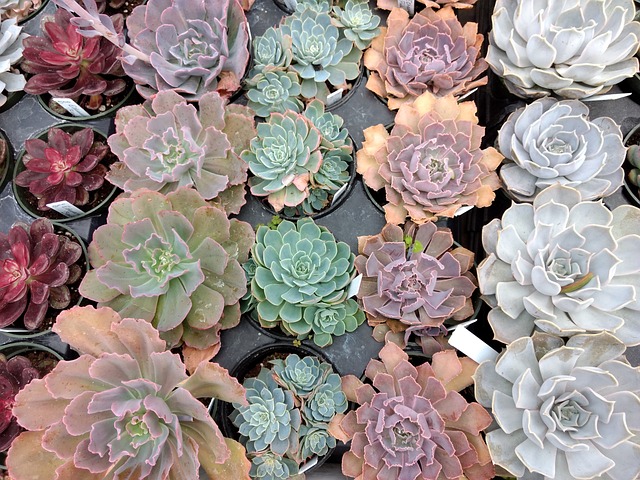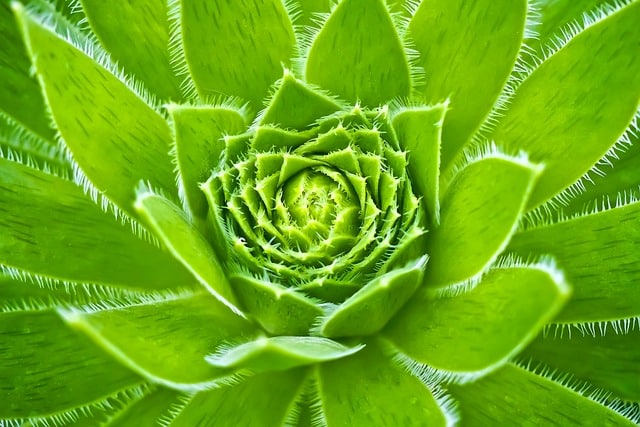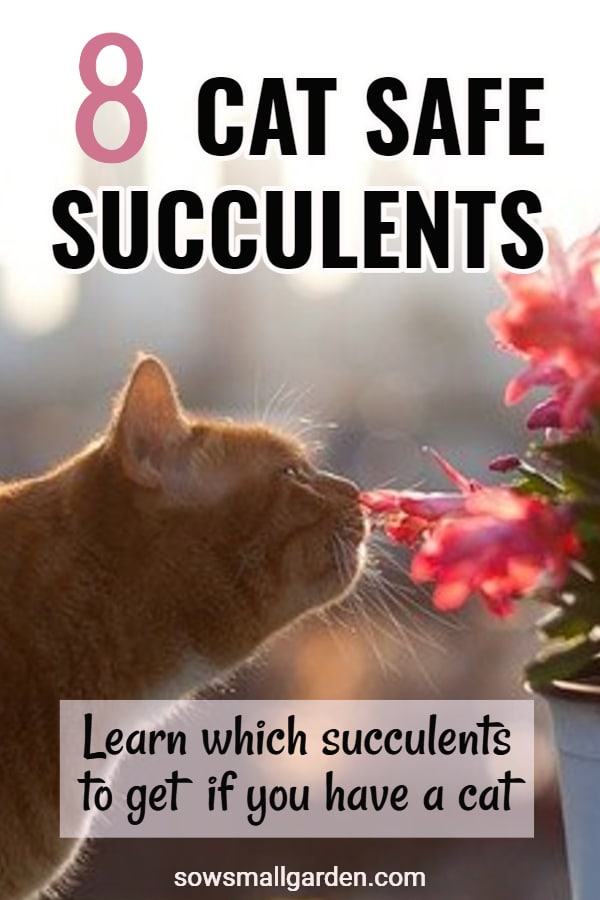Last Updated on October 1, 2023
Are there any succulents that are safe for cats? Yes, there are, and this guide to cat-safe succulents will provide you with all the knowledge you need.

If you’re a proud cat owner and a succulent enthusiast, finding the perfect balance between greenery and pet safety is crucial. Fortunately, there are several stunning succulents that not only add a touch of elegance to your space but are also safe for your feline friends.
*This post contains affiliate links. If you choose to purchase any of the products I have recommended, I may receive a commission at no cost to you.
Are succulents safe for cats?
Oh, those little succulents with fleshy chunky fat leaves in little cute pots… when you see them in Home Depot or online stores, it’s hard to resist not buying at least one. But, as a pet owner, you probably wonder: Are succulents safe for cats? Should I just bring them home and hope for the best?
The short answer is: your worry is warranted, because there are some popular succulents that are bad for cats when ingested.
Read related: 6 succulents toxic to cats.
But the good news is that the majority of succulents are not toxic to cats, and in this article we’ll equip you with a list of hardy low maintenance succulents that can be freely kept at home and will coexist in peace with your cats.
Cat safe succulents
Now, let’s take a look at 8 succulents that are safe for cats.
1. Holiday cacti (Schlumbergera)

There are 3 types of “holiday” cacti: Easter cactus (Schlumbergera gaertneri), Thanksgiving cactus (Schlumbergera truncata), and Christmas cactus (Schlumbergera buckleyi).
Each holiday cactus typically blooms with beautiful red, pink, or yellow flowers closest to the holiday that it’s named after. As holiday time flowering houseplants, they make a great addition to nearly any indoor setting.
All of them are succulents safe for cats so you can freely grow them indoors and place them around the house thanks to their non-toxicity.
I should note a peculiarity about these plants though: unlike most succulents, Holiday cacti can’t handle full sun well. Also, they need to be watered more frequently compared to usual succulents. Otherwise, they are very easy to care for and can live over 50 years!
Holiday cacti propagate easily too, making them an exceptional candidate for holiday gift-giving.
Do you know?
All cacti are succulents, but not all succulents are cacti.
* cacti – common plural for cactus (though both “cactuses” and “cacti” are acceptable).
2. Burro’s Tail (Sedum morganianum)
also known as Donkey’s Tail, Lamb’s tail, or Cluster Sedum

Donkey’s Tail is another safe for cats succulent.
It’s native to Mexico and grows best in hanging baskets or in a vessel from where its stems, covered with rounded and fleshy silver-green leaves can hang down freely.
Burro’s tail plant can grow as long as 4-6 feet, but it can take years to reach full maturity
Overall, this perennial succulent is easy to care for, it can tolerate any type of soil with good drainage. This plant will be happy if you give it bright morning sunlight. It requires more watering compared to the majority of succulents to keep its leaves nice and plump. However, be sure to let the soil completely dry between waterings.
3. Ponytail Palm (Beaucarnea recurvata)
also known as Bottle palm tree or the Elephant foot tree.

Ponytail Palm is a pet-safe, easy to grow succulent from the Agave family, known for its unusual look, low maintenance and longevity.
Ponytail palm has a bulbous trunk which is used to store water, and hair like leaves that create its famous ponytail look.
This “not actually a palm” plant is quite forgiving: it can grow in any light condition and, as a majority of succulents, does not require much watering. You can even keep it outside during summer and bring inside your home during cold months.
4. Zebra Haworthia (Haworthia attenuata)

While most Haworthia species are safe for cats, the Zebra Haworthia is the most popular among them. Thanks to its attractive appearance – thin, dark green leaves with horizontal white ridges that resemble zebra striping – Zebra Haworthia is often chosen by succulent lovers for an indoor plant.
Zebra Haworthia doesn’t require much maintenance: it needs little water, just like most succulents do, so be sure the soil is completely dry before the next watering. (yellow leaves are a sign of overwatering.) It also thrives in gritty soil with good drainage and in sunny locations.
This plant offsets freely, and can be easily propagated from offsets to make a delightful succulent jungle for your cat. 🐈
5. Echeveria

Echeverias are so pretty and there are so many varieties to choose from! Their attractive rosettes, which can be short-stemmed or hanging from the stem, vary in shapes, shades, colors, and sizes. The leaves in rosettes can be smooth or furry, thin or thick. You can find a special echeveria plant to your liking for sure, or better yet, get a set of echeveria plants with different looks.
And the good news is that echeverias are totally safe and not poisonous to cats and dogs.
Echeverias will do well in bright light and in well-drained soil. They’ll take neglect and drought but won’t tolerate wet and cold conditions. Always water the soil directly, and be sure that the water does not sit on the rosette because this can lead to rot and fungal disease.
6. Sempervivum (Sempervivum tectorum)
often called Hens and Chicks.

These nice looking succulents with pretty green and red rosettes are commonly grown in indoor or outdoor containers, but they can also be grown as a groundcover in USDA zones 4-8.
People commonly call Sempervivum plants “Hen and Chicks”, because once you plant a mother “hen” plant the babies “chicks” will start to develop. The hen plant will be attached to the chicks (babies) by an underground runner. The mother plant can grow as large as a saucer, and the babies will vary in size, some can be as little as a dime. One Sempervivum plant can spread to 2 feet, creating a low growing mat of rosettes.
Don’t hesitate to get Sempervivum. Your cats will be amused by it, and no harm if they decide to taste it.😊
As most succulents, Sempervivum will thrive in full sun and a well-drained gritty soil.
Rosette forming succulents – like Echeveria and Sempervivum are great candidates for a living wall (indoors or outdoors).
How do you make a living wall?
Search YouTube for “living wall” or “living wall art”, watch short YouTube videos, and get inspired to create your own succulent living wall art.
7. Opuntia
These plants are also known as the Cactus pear, the Paddle cactus, Nopal, Sabra, Barbary fig, and Indian fig.

I bet you saw opuntia paddle like leaves (which are actually stems), also known as nopales, sold in supermarkets. And what does it tell you? You are right! Prickly pear’s leaves are edible and can be cooked as a vegetable, So, no harm if ingested by humans, or cats.
The fruits, also known as tunas, are edible too. They can be different colors and sizes and the sweetness depends on ripeness.
This type of cactus grows in dry regions of the Americas, the Mediterranean, Australia, and Africa. Opuntia cactus thrives in full sun and prefers alkaline to neutral gritty soils that drain well. Soggy soil will rot the plant.
You can grow opuntia outdoors or as a house plant. When you grow it indoors, its better to move the pot to a sunny deck or patio during summertime.
And when you are getting your non-toxic cat plant – better go for spineless variety, it will be much safer for you and your cats.
8. Dragon Fruit (Hylocereus undatus)
also known as pitaya or pitahaya.

You can own a dragon fruit tree without much worrying about your pets eating it.
Dragon fruit, which is actually a cousin of Cactus pear, is a fun succulent to grow outdoors for tasty fruit if you live in USDA 9-11 hardiness zones.
But if you live in colder climates, don’t despair. You can place pitaya indoors in a container near a sunny window. This plant takes pruning well, so it can be kept in a nice compact size.
Read related:
Final thoughts on safe for cats succulents
Cats and succulents: good mix or not?
Sure it is, if you get the right plants.
Now you know which common succulents are safe for cats, so you can choose cat-friendly succulents for your own peace of mind and for the safety of your feline friend.

You have read:




